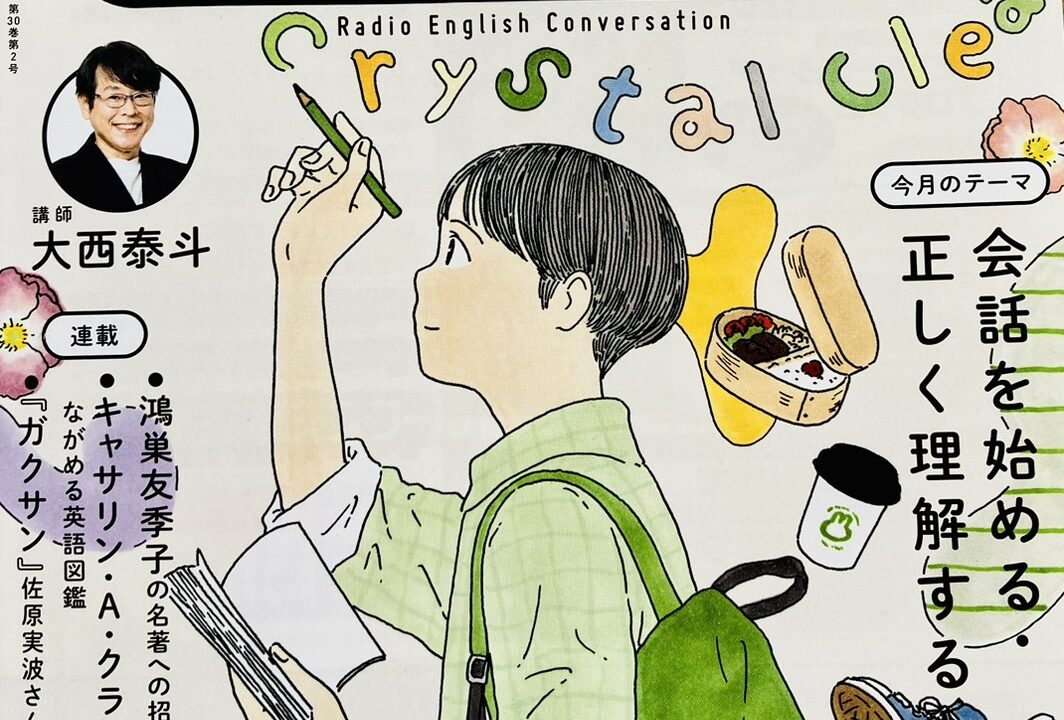【ラジオ英会話】Lesson 29 発言タイプ:理解を深める②相手の真意を引き出す – May 18 Thursday, 2023

May 18 Thursday, 2023
Lesson 29 発言タイプ:理解を深める②相手の真意を引き出す
☆Words & Phrases
That new song sounds good. I love it.
**lack:
What do you mean? – It’s lacking something.
**bush:
**make one’s point:
Stop beating around the bush and make your point.
**get at ~:
What are you getting at?
**direction:
We need to move in a new direction.
☆direction の発音
O: Hey, David. How do you pronounce this word?
D: I usually say [dɑɪékʃən]. How about you, Roza?
R: I usually say [dəˈɹɛk.ʃən].
No way!

☆Grammar and Vocabulary
① The band isn’t what it used to be.
used to(以前は~だった)
イメージは「現在とのコントラスト」で「今はそうではない」が色濃く感じられるフレーズ。
この文では wh節で用いられ「以前そうであったもの」となっている。
② What do you suggest?
suggest の提案
語感は至って軽やかで「~したらいいんじゃないかな?」
同じ提案系の動詞 propose(提案する)の持つ、正式で練りに練った、といったニュアンスは suggest にはない。
意識して使い分けるようにする。

友だち追加↓で毎朝8時にLINEで『ラジオ英会話』のまとめが届きます。
毎日の学習の復習、見直しなどにご活用ください。役立つ英語のコラム付き♪
☆Typical Expressions
Stop beating around the bush and make your point.
要領を得ない相手から真意を積極的に引き出す表現。
beat around the bush は「藪の周りを叩いて獲物を追い出す → 遠回しに言う」 – ハンティング(狩猟)から生まれた表現。
make one’s point は「ポイント(意見)をハッキリ言う」ということ。
① What are you getting at?
→ get at は「言おうとする・意図する」。動きを表す get と「点」を表す at のコンビネーション。「~に向かう」感触。


② Come to the point, will you?
Get to the point, will you?
→ point は「ポイント=要点・核心・言いたいこと」
come, get でポイントにたどり着く動きが表現されている。
③ What are you trying to say?
→ try to ~ は「~しようと試みる、~しようと頑張る」で、try と矢印(→)のイメージを持ち「これから」が感じられる to不定詞とのコンビネーション。
④ Spit it out!
→ spit は「吐く」。隠している真相などを「吐かせる」ための強烈な表現。
Just spit it out already!
はドラマにも出てきそう。
☆Practice
D: All right! It’s time for practice. The important point for today’s lesson is tone. It’s very easy to sound angry or frustrated using these sentences.
Let’s try this first one with “the soft tone.” Okay? Here we go.
– What are you getting at?
……
R: Let’s try the last one, one more time. And this time let’s make “will you” into “will-ya”
– Get to the point, will-ya?
Excellent!
D: All right. For the next one, let’s be frustrated. Use your tone to sound angry.
– What are you trying to say?
……
R: Well, now a case, let’s go to our last example.
– Spit it out!
Here, let’s use the angry tone again. One more time.
……
D: Well, when you say it like that, it’s super effective.
R: Right. Anyway, great work, guys.
D: That was excellent!
☆Typical Expressions in Action
①何を言おうとしているのですか?話が見えません。
②何を言おうとしているのですか?私があなたの腕時計を盗んだって?
**steal:
③回りくどい言い方はやめて、ハッキリ言ってくれませんか?私たちには無駄にする時間はないのです。
**no time to waste:
May 18 Thursday, 2023
Lesson 29 発言タイプ:理解を深める②相手の真意を引き出す
(日本語訳・解説付き)
☆Words & Phrases
That new song sounds good. I love it.
あの新曲はよさそうです。私は気に入りました。
※説明型オーバーラッピング(SVC)の文です。That new song = good に聞こえる(sound) と、sound の意味が文全体にオーバーラップしています。
**lack: 不足する
What do you mean? – It’s lacking something.
どういう意味ですか? – 何かが不足しています=何かが足りないのよ。
**bush: やぶ、茂み
**make one’s point: ポイント(意見)をはっきり言う
Stop beating around the bush and make your point.
回りくどい言い方はやめて、ハッキリ言ってください。
**get at ~: ~を意味する・ほのめかす
What are you getting at?
あなたは何をほのめかしているのですか?=何が言いたいんだい?
**direction: 方向
We need to move in a new direction.
私たちは新しい方向を目指す必要があります。
※ need to ~ は「(これから)~することを必要がある」ので矢印(→)の toとピッタリですね。
※方向には in が使われます。The sunsets in the west.(日は西に沈む)など。方向がある種の「範囲」と考えられているためです。

☆direction の発音
O: Hey, David. How do you pronounce this word?
D: I usually say [dɑɪékʃən]. How about you, Roza?
R: I usually say [dəˈɹɛk.ʃən].
No way!
まさか!・とんでもない!

☆Grammar and Vocabulary
① The band isn’t what it used to be.
このバンドはかつてそうであったものではありません。
used to(以前は~だった)
イメージは「現在とのコントラスト」で「今はそうではない」が色濃く感じられるフレーズ。
この文では wh節で用いられ「以前そうであったもの」となっている。
② What do you suggest?
あなたは何をすすめますか?
suggest の提案
語感は至って軽やかで「~したらいいんじゃないかな?」
同じ提案系の動詞 propose(提案する)の持つ、正式で練りに練った、といったニュアンスは suggest にはない。
意識して使い分けるようにする。

友だち追加↓で毎朝8時にLINEで『ラジオ英会話』のまとめが届きます。
毎日の学習の復習、見直しなどにご活用ください。役立つ英語のコラム付き♪
☆Typical Expressions
Stop beating around the bush and make your point.
回りくどい言い方はやめて、はっきり言ってください。
要領を得ない相手から真意を積極的に引き出す表現。
beat around the bush は「藪の周りを叩いて獲物を追い出す → 遠回しに言う」 – ハンティング(狩猟)から生まれた表現。
make one’s point は「ポイント(意見)をハッキリ言う」ということ。
① What are you getting at?
何を言おうとしているのですか?
→ get at は「言おうとする・意図する」。動きを表す get と「点」を表す at のコンビネーション。「~に向かう」感触。


② Come to the point, will you?
Get to the point, will you?
ハッキリ言ってくれませんか?
→ point は「ポイント=要点・核心・言いたいこと」
come, get でポイントにたどり着く動きが表現されている。
③ What are you trying to say?
何を言おうとしているのですか?
→ try to ~ は「~しようと試みる、~しようと頑張る」で、try と矢印(→)のイメージを持ち「これから」が感じられる to不定詞とのコンビネーション。
④ Spit it out!
白状しろ!
→ spit は「吐く」。隠している真相などを「吐かせる」ための強烈な表現。
Just spit it out already!
いいかげん吐いたらどうだ!
はドラマにも出てきそう。
☆Practice
D: All right! It’s time for practice. The important point for today’s lesson is tone. It’s very easy to sound angry or frustrated using these sentences.
Let’s try this first one with “the soft tone.” Okay? Here we go.
– What are you getting at?
……
R: Let’s try the last one, one more time. And this time let’s make “will you” into “will-ya”
– Get to the point, will-ya?
Excellent!
D: All right. For the next one, let’s be frustrated. Use your tone to sound angry.
– What are you trying to say?
……
R: Well, now a case, let’s go to our last example.
– Spit it out!
Here, let’s use the angry tone again. One more time.
……
D: Well, when you say it like that, it’s super effective.
R: Right. Anyway, great work, guys.
D: That was excellent!
☆Typical Expressions in Action
①何を言おうとしているのですか?話が見えません。
What are you getting at? You lost me.
※ You lost me. 「あなたは私を迷子にした→話が分からない・ついていけない」ということ。
I’m lost.(私は迷子になってしまった)よりも「相手のせい」が強調された表現。
②何を言おうとしているのですか?私があなたの腕時計を盗んだって?
What are you trying to say? That I stole your watch?
**steal: 盗む
③回りくどい言い方はやめて、ハッキリ言ってくれませんか?私たちには無駄にする時間はないのです。
Stop beating around the bush and make your point, will you? We have no time to waste.
**no time to waste: 浪費する時間はない
May 18 Thursday, 2023
Lesson 29 発言タイプ:理解を深める②相手の真意を引き出す
(日本語→英語バージョン)
☆Words & Phrases
あの新曲はよさそうです。私は気に入りました。
→
※説明型オーバーラッピング(SVC)の文です。
**不足する:
どういう意味ですか? – 何かが不足しています=何かが足りないのよ。
→
**やぶ、茂み:
**ポイント(意見)をはっきり言う:
回りくどい言い方はやめて、ハッキリ言ってください。
→
**~を意味する・ほのめかす:
あなたは何をほのめかしているのですか?=何が言いたいんだい?
→
**方向:
私たちは新しい方向を目指す必要があります。
→
※方向には in が使われます。The sunsets in the west.(日は西に沈む)など。方向がある種の「範囲」と考えられているためです。

まさか!・とんでもない!
→
① 何を言おうとしているのですか?
→ get at は「言おうとする・意図する」。動きを表す get と「点」を表す at のコンビネーション。「~に向かう」感触。


② ハッキリ言ってくれませんか?
→ point は「ポイント=要点・核心・言いたいこと」
come, get でポイントにたどり着く動きが表現されている。
③ 何を言おうとしているのですか?
→ try to ~ は「~しようと試みる、~しようと頑張る」で、try と矢印(→)のイメージを持ち「これから」が感じられる to不定詞とのコンビネーション。
④ 白状しろ!
→ spit は「吐く」。隠している真相などを「吐かせる」ための強烈な表現。
いいかげん吐いたらどうだ!
はドラマにも出てきそう。
『ラジオ英会話』がビジネスシーンでの「英語雑談」に最強な理由
名古屋駅前にあるビジネス英語&仕事での英語雑談力をつけるための「名古屋BEGビジネス英会話ジム」
営業時間:平日 9:00~22:00 土曜日 9:00~19:00(日祝休み)
〒450-0002 愛知県名古屋市中村区名駅2丁目40-16 名駅野村ビル 5階
TEL:080-6900-1868
生徒さんのご感想
アクセス
お問い合わせフォーム
お電話でのお問い合わせ 080-6900-1868


